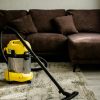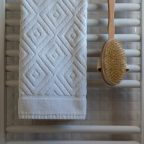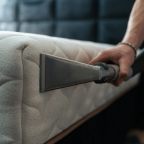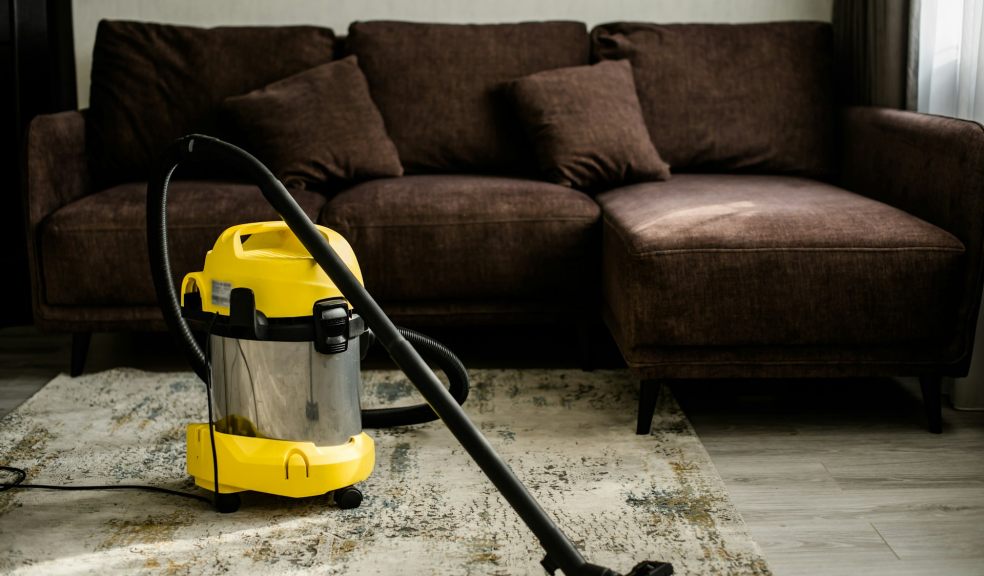
How to Clean a Carpet – Including Deep Cleaning and Stain Removal
Look up any “most hated chores in the UK” survey, and you’ll notice one glaring absence — carpet cleaning. Apparently, your average Brit hates cleaning the oven, regrouting tiles, fixing loose door handles, and dusting the TV (!?) more. That’s odd, because most people definitely don’t know how to clean carpets properly. Maybe you’ve just given up and accepted the less-than-pristine status quo?
Don’t fall into that trap. If you don’t know how to clean a carpet (thoroughly!), more’s at stake than your status as a house-proud person. Dirty carpets are bad for your health — they harbour dust, allergens galore, mould and fungi, pet dander, mite dander (ew), volatile organic compounds, and other nasties. That stuff doesn’t just stay in your carpet. It negatively impacts your indoor air quality.
We can’t have that, can we?
Keeping your home or commercial space feeling healthy and looking sparkly takes some planning — and the three pillars of carpet cleaning are regular maintenance, deep cleaning and stain removal. Here’s how to do it right.
What You Should (Ideally) Know Before Tackling Carpet Cleaning at Home
You’re probably ready to roll up your sleeves and get to work, but a few things should definitely be on your radar before you decide how to clean a carpet. These things can make or break your carpet-cleaning success, so at least give this section a quick skim.
Carpet Materials — What They’re Made Of and Why It Matters
You cannot decide on the best way to clean carpets without knowing what they’re made of. Different materials behave differently, and your approach to cleaning should take that into account:
· Wool carpets are still quite common in the UK. Avoid alkaline cleaners and excessively hot water for these. Blot, don’t scrub. Always use WoolSafe cleaning products. Wool takes ages to dry, so your space must be well-ventilated if you don’t want to invite mould.
· Nylon carpets are hardy and durable. They can take a bit of a beating, so steam cleaning and heavy-duty commercial cleaning products will get them nice, sparkly, and dirt-free in no time. Don’t blast them with too much heat, though. Given excessively high temperatures, nylon carpets can melt.
· Carpets made of natural fibres like jute, sisal, and hemp are sustainable, but they’re often a nightmare to clean. Get them wet, and they’ll reward you with brown stains. Sprinkle them with bicarbonate of soda and hoover them.
· Olefin (polypropylene) carpets are a dream to clean. Stains basically chill on top because this synthetic refuses to absorb anything. It doesn’t like heat, though.
· Blends like 80% wool/20% nylon are the most common. Let the dominant fibre decide your cleaning strategy.
Environmental Factors That Wreck Your Carpets
Sometimes, the deck is stacked against you — so stack it right back.
High relative humidity levels and rising damp (not unheard of in older ex-council houses) make for moist carpets. That causes musty smells and darker patches. If it’s bad enough, your carpets lift or get mouldy. Ventilation isn’t optional. A dehumidifier wouldn’t hurt, either. (Still got carpets in your bathroom? There’s a reason people in the rest of the world don’t. Tiles are a fantastic choice if you’re already thinking about a remodel.)
Rain + rural area + muddy boots = for Pete’s sake, make people take their footwear off before walking on your carpets. That settles that. Get an indoor doormat and set up one of those nice shoe storage benches.
Urban grime + fluffy carpet = bring all that inner city pollution right inside. Hoover more often to keep your carpet (mostly) dust- and pollution-free — yes, every day if you have to. Again, consider a “no shoes indoors” policy.
Carpet Cleaning Products You Definitely Want to Keep in the Cupboard
You’ll want to keep that cleaning cupboard stocked up with various carpet cleaning supplies,because besides your planned routine maintenance and deep cleaning sessions, carpet cleaning at home can also involve emergencies. Spills that don’t get cleaned up right away have the potential to become stubborn stains on your carpet. Please visit now.
There’s something for everyone here, so pick and choose.
Commercial carpet cleaning products you might want to keep on hand include:
· Dry carpet cleaning powder — good for waxy or oily stains and odours
· Carpet shampoo — for deep cleans and post-stain removal cleaning
· Enzyme cleaner — for sick, pet messes, and milk stains
· Vanish Oxi Action or a similar non-chlorine bleach product — for red wine, old tea stains, or blood
· Stain guards to prevent dirt build-up after cleaning
Want DIY and natural carpet cleaning agents that work, including for spot cleaning? Stock up on:
· Bicarbonate of soda — absorbs odours, helps clean up stains
· White vinegar — neutralises odours
· Hydrogen peroxide (never with bleach!!!) — for blood and red wine
· Isopropyl alcohol — a very gentle solvent
· Washing-up liquid — gentle and all-purpose
· Salt — soak up liquids and help clean food stains
· Essential oils — to make that carpet smell great
As for the other tools of the trade, you’re definitely going to need:
· A powerful vacuum cleaner with a HEPA filter — and keep that filter clean!
· (A carpet cleaning machine is great — but you don’t absolutely need it to get the job done. If you have one, use distilled water for it!)
· A carpet brush
· A soft-bristled scrub brush
· Spray bottles
· Microfiber cloths
· A lint roller
· A little plastic scraping tool (a spoon works, too)
· Cleaning or surgical gloves
· A fan or dehumidifier — or multiple
How to Keep Your Carpets Clean with Routine Maintenance
Knowing how to clean a dirty carpet (you know, truly dirty) is important, but a little maintenance goes a long way. Keep dirt build-up and nasty odours at bay, and you won’t need to deep clean your carpets nearly as often.
Hoovering is (nearly) everything here. Use a powerful vacuum with a good HEPA filter — ideally Allergy UK-approved if you’ve got allergies or pets. Zoom through your most-used areas every two to three days, or daily if that “pet or allergy” category applies.
Do a deep vacuum at least once a week. Sprinkle soda bicarb (with a drop of essential oil if you like) or a deodoriser on the carpet before slowly attacking it from all directions. Don’t forget about skirting boards and other edges. Move furniture out of the way to vacuum underneath once a week. As for area rugs, shake them out or beat them outdoors (or hoover if you have nowhere to do it).
Open your windows for at least 15 to 30 minutes a couple of times a week — the more often, the better. If you live on a main street, do that when there’s not much traffic. Absolutely consider a dehumidifier. These steps preempt mould, which kills carpets and can make you sick.
Got pets? Two words: lint roller.
How to Deep Clean Carpet at Home (Properly)
Deep cleaning can help you get rid of stains — but it also attacks the dirt and grime that inevitably settles into the fibres over time. Ideally, do a deep clean every three months or so (AKA whenever the season changes).
How to Deep Clean a Carpet with a Carpet Cleaning Machine
https://www.youtube.com/watch?v=FW3pT9vHsEE
Don’t worry if these machines are outside your budget. You can rent them. Using a carpet cleaning machine is a little intimidating the first time, but it’s quite simple.
You’ll want to prep in sections — move furniture to the other end of the room. Give the area a thorough hoover and use an enzyme cleaner (or appropriate stain remover, more about which later) on stubborn stains.
Fill the machine with hot (but not boiling) distilled water and a machine-compatible liquid carpet cleaning product. The product of your choosing will have ratio instructions. Follow those. Push the machine forward to get cleaning agents into your carpet. Pull it back to soak everything back up. Go back and forth a few times.
Let your carpet dry completely. Refrain from walking on it in the meantime. Pull out all the stops — fans, open windows, dehumidifiers, you name it. Return all your furniture and move on to the next area.
How to Clean Without a Machine
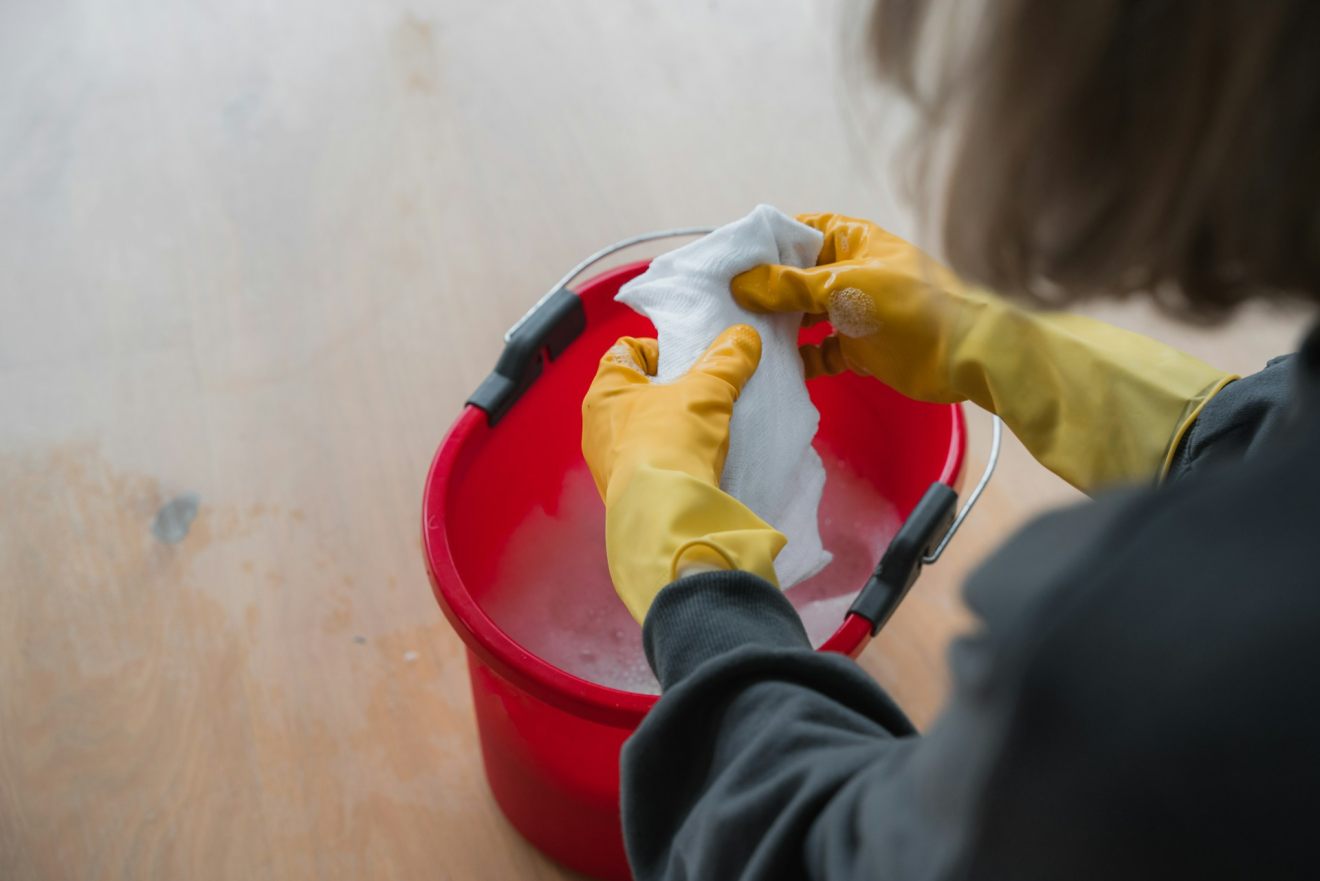
If you’re wondering how to clean a carpet without a carpet cleaner, it’s not much more difficult than using a machine. Manual carpet cleaning does take a lot more work, though.
Start off the same way — move furniture and hoover thoroughly. Now, dust soda bicarb or a dry carpet cleaning powder over the area. Let it sit and vacuum again — tackling the carpet from all directions in a criss-cross fashion.
Mix up:
· Warm water (not hot!)
· A few drops of washing-up liquid
· A splash of white vinegar
· A drop of essential oil
Or use a commercial carpet cleaning solution.
You’ve now got two options — use a spray bottle to apply it, or get on your hands and knees for a good, old-fashioned scrubbing session. If you pick option 2, be careful not to soak the carpet. A little goes a long way.
Use a carpet brush, soft-bristled brush, or even a broom to scrub the area. Remember — if you want to know how to clean a carpet by hand without damaging it, you need to know your fibres. Wool? Go easy. Massage, don’t scrub. (It felts.) Synthetics? They can handle a bit more.
Done? Great! Now, blot the area to soak up some of that moisture. Microfiber cloths are great for that. Towels and or paper kitchen towels work, too. Rinse with warm water, using the same method.
Open all your windows up, blast those fans, and wait for your carpet to dry.
Is this manual method effective? You bet. It doesn’t go quite as deep as machine cleaning, though, so you may have to do it more often.
How to Wash a Carpet or Area Rug
Some area rugs can go in the washing machine. You’ll want to look at the care label to decide. On the off chance that your label is gone, cotton is nearly always washing-machine safe and synthetic fibres often are, too. Rugs made of anything else shouldn’t go in the machine. Especially not wool, sisal, or jute.
If your area rugs can be machine-washed, you don’t need any instructions beyond these. Shake your rugs out first, and vacuum them before popping them into the machine. Let them dry properly after, ideally outside.
As for how to clean a small carpet or area rug by hand, it’s basically the same as the “how to clean a carpet without a machine” method. Except you can take it outside and let it dry in the sun.
Find Out How to Remove Carpet Stains (Safely, by Type!)
Life happens. Stains follow. The first rule of knowing how to get stains out of carpet is that every type of stain requires a different approach. Ready?
How to Get Blood Out of Carpet
Blood stains are always cleaned up with cold water. Add a few drops of washing-up liquid and use a microfiber cloth or hand towel to dab the stain. Absolutely no scrubbing! Rinse with cold water and blot the spot dry. The faster you act, the easier it is to remove carpet stains of this nature.
For stubborn, old blood stains on a carpet, try hydrogen peroxide — apply just a little, let it fizz, and then follow up with cold water + washing-up liquid.
(Not your blood? Gloves mandatory.)
How to Get Paint Out of Carpet
For fresh paint:
· Get water-based paints like latex or acrylic out with washing-up liquid and hot water. Dab, don’t scrub. Rinse.
· Oil-based paints are tricky. Take as much as you can away with some kitchen paper. Isopropyl alcohol is the safest bet for synthetic carpets, but turpentine or acetone can work on wool carpets. Dab the spot until the paint is most of the way gone. Follow up with soapy water.
Dry paint is different. Gently scrape most of it off using a little pry tool, a credit card, or a blunt knife. Then follow the same procedure for the offending paint type.
Solvents do risk damaging your carpet, especially synthetic fibres. If you want an all-natural solution, some swear by citrus oil. If not, commercial carpet paint removers exist.
How to Get Wax Out of Carpet
This one’s easier than you think. Freeze the wax with an ice cube and scrape off as much as you can.
Then:
· Heat with a hair dryer or an iron on very low heat and blot with a plain white kitchen towel.
· Scrape + soapy water for synthetic carpets sensitive to heat.
Still got a carpet stain? If it was crayon wax or scented candle wax, there are probably oils. Citrus cleaner or isopropyl alcohol can make short work of those.
How to Get Nail Polish Out of Carpet
Nail polish stains are some of the most persistent out there. Acetone will get rid of them, but it might also burn a hole in your (synthetic) carpet. Go for an acetone-free nail polish remover or isopropyl alcohol as your main stain remover.
Spot-test your chosen stain remover. No damage done? Apply it to a cotton ball and start dabbing the stain. Scrubbing only works it in more deeply. Nearly gone? Rinse and follow up with soapy water. Old nail polish? Scrape as much of the nail polish as possible off with a dull knife, small pry bar, or (old) credit card and then go ahead with the previous steps.
How to Get Burn Marks Out of Carpet
Sorry, but burn marks permanently damage your carpet. If the burn is mild enough, you can trim it off with a pill remover/fabric shaver or a very sharp pair of little scissors. If not, hide and cover or cut out a square and replace it with a new square — if you have extra lying around.
How to Get Red Wine Out of the Carpet
Fresh spill? Hurry — time is of the essence! Soak most of it up with a kitchen towel. Apply cold water + washing-up liquid. When clean, dust the spot with salt or soda bicarb to clean up residual pigment. Let it dry and then hoover.
Old stain? All’s not lost if you know how to get tough stains out of a carpet. Rehydrate the red wine with that same DIY cleaning solution and start blotting — or buy a good commercial carpet shampoo. Hydrogen peroxide can also work for red wine stains.
How to Get Sick Out of Carpet
Cleaning up sick is nobody’s hobby. It’s full of nasty enzymes, proteins, acid, and bits you’d rather not deal with. Not your sick? Not your kids’ sick? Gloves. (And maybe an N95, just ‘cause.)
Scoop up any solids, ideally with a disposable spoon or something else you can toss after. Use a paper towel to soak up the first layer of wet stuff. Press and wait. Don’t scrub. Enzyme clear is your best friend here, because it rocks at cleaning up organic spills. Throw some soda bicarb on after, let it dry, and vacuum it up. Then, get scrubbing with a commercial carpet shampoo or a mix of washing-up liquid, vinegar, and cold water.
Rinse… and probably repeat, because you might need a few rounds to get all the nasty odours out.
How to Get Tea Stains Out of Carpet (Also Works for Coffee)
Clean fresh tea or coffee spills up quickly with a classic cold water + white vinegar + washing-up liquid solution — or, if you have a commercial carpet shampoo, bring that out to play. As with most types of carpet stains, blot the spill. Don’t scrub.
Old stain? Mix water and bicarbonate of soda until you end up with a thick paste. Dab it on. Let it dry. Scoop off most of the paste and hoover the rest.
How to Get Shoe Polish Out of Carpet
The bad news? Shoe polish is waxy, full of pigment, and designed to stick around. You’re not going to have a great time. Step by step:
· Scrape off what you can.
· Blot off what doesn’t scrape off with a paper towel.
· Use soda bicarb or a dry carpet cleaning powder to absorb some of the oils.
· A 70% isopropyl alcohol solution is pretty effective at getting rid of the rest.
· Finally, use water + washing-up liquid or a commercial carpet shampoo.
How to Get Rid of Carpet Beetles and Moths
Not all carpet threats are stains. Carpet beetles and moths are very different beasts, but the way to deal with them is nearly identical.
Vacuum thoroughly, especially around areas where you’ve seen larvae. Throw hoover bags away. Clean bagless canisters well. Immediately wash all fabrics in sight to attack all critters on all fronts.
Get a spray bottle, fill it with water, and add a splash of isopropyl alcohol with around three or four drops of lavender essential oil (a mild moth repellent). Cloves and bay leaves work against carpet beetles. Add those, too.
Follow that up with diatomaceous earth — it’s non-toxic to humans and pets, but suffocates pests. Generously sprinkle it around your carpet, let it sit (ideally overnight, but a few hours still helps) and vacuum.
This covers carpet first aid, but you still have a pest problem. Our advice? Whilst you can use sticky and pheromone traps to try to break the pests’ reproductive cycle, your belongings are too valuable to take any chances. Call a pest control specialist.
When to Call the Pros — Or Replace Your Carpet Entirely
Did you give DIY carpet cleaning at home your very best shot, but are you still stuck with stubborn stains, musty smells, or perpetual damp? It’s time for professional carpet cleaning services.
Even the pros can’t fix the problem if your carpet is simply worn out. Wall-to-wall carpet lasts, on average, five to 15 years (25 for natural wool). Beyond that, you’re on borrowed time. Those frayed threads won’t fix themselves.
How to Clean a Dirty Carpet FAQs
Didn’t see the answer to your question up there? Perhaps it’s waiting for you here.
What is the best homemade carpet cleaning solution?
Use this formula to create a carpet-safe and effective DIY cleaning solution:
· Fill a spray bottle with cold water
· Add a few capfuls of white vinegar
· Add a few drops of washing-up liquid
· Drop in a few drops of lavender essential oil
Why do you warn against scrubbing when removing stains from carpets?
Vigorous scrubbing risks working the stain in more deeply. Blot instead. Your goal is to transfer the stain from your carpet to a microfiber cloth or paper towel.
Do I need to do a spot test before removing stubborn stains?
Always do a spot test — you never know how your carpet might react, and it’s better to be safe than sorry.
Is it OK to spray vinegar on carpet?
Vinegar is often recommended for carpet cleaning because it neutralises odours and breaks down alkaline stains. It can damage some fibre types and even set dye, ink, or grease stains, though. Spot-test first. Vinegar can be helpful, but it’s not a cure-all.
What are the top carpet cleaning mistakes?
Some of the worst offenders include:
· Not vacuuming often enough. Hoover at least every week, and ideally at least every three days, to prevent dirt from being worked into the fibres.
· Using too much water, so your carpet doesn’t dry properly — a huge mould risk.
· Not spot-testing first.
Is carpet stain protection worth it?
Commercial stain protectors do work to protect your carpet from many stains — for around 30 days. They can save you time, hassle, and money. They don’t make your carpet stain-proof, so still be careful.









